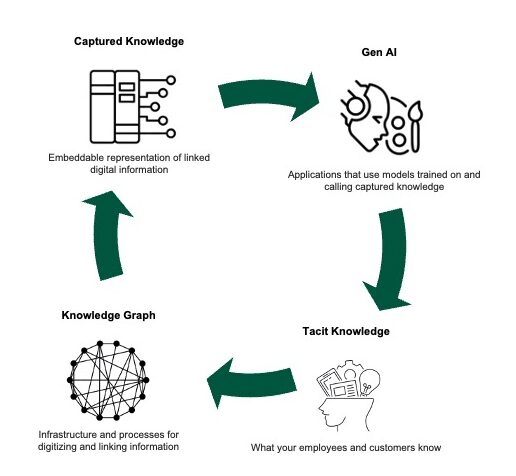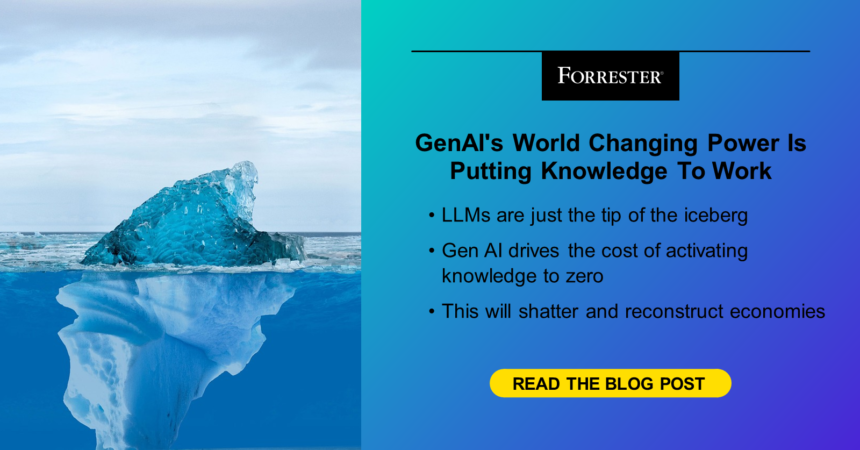Generative AI (genAI) is a disruptive force, but just how disruptive? We all know that “it will be big.” But we are not quite sure just how big. My colleagues have explored aspects of this via recent research: The Generative AI Advantage and Forrester’s 2023 Generative AI Jobs Impact Forecast, US. I am kicking off a new research stream with Ted Schadler, Julie Mohr, and others to further explore this topic. Our focus is the disruptive impacts that genAI will have on industries, markets, and economies. Today, companies in every industry are pursuing value from genAI, but this pursuit kicks off a cycle that will ultimately change industries, tech priorities, and markets, labor forces, and governments. Last week, Ted published our first blog on the topic: GenAI Will Shatter And Reconstruct Every Company And Industry. He poses some big questions at a business level about the fundamental economic forces that are being unleashed and how they will extend far beyond the current productivity-boosting wave that is coming.
The next step of this research stream is diving into the why and the technical how. We have two beliefs:
- GenAI drives the cost of knowledge activation toward zero. Information technology drove the cost of data to zero, but using data to create value is still expensive. GenAI will blow up markets built around these costs because it can distill information into knowledge, on demand, at an inhuman scale. No business is safe from this disruptive force, and natural language is just the tip of the iceberg — code generation, material discovery (chemistry alone is a $5.7 trillion industry), architecture and engineering planning, and others. No body of human knowledge or firm that depends on it is out of reach. This will also have a huge consumer impact.
- GenAI closes the knowledge cycle. GenAI creates a virtuous loop of expanding knowledge that will elevate demand for more captured knowledge to drive genAI. In simple terms, the more a company gains from genAI, the more it will lean into it, investing more and in hopes of capturing more and more knowledge. This kicks off a continuous cycle that will accelerate the impact of GenAI in every company. This will create new channels of value delivery, new industries, and big threats for those that do not adapt. GPT-3 unleashed that engine a year ago, but it is just spinning up. This will feed the next-generation private knowledge models — around, apart, and up we will go.

But just because these two realities impact every industry does not mean that this disruption will hit every firm equally. We believe that the impact will be based on use of knowledge to create business value. For example:
- Firms that capture high-expertise knowledge will create value through amplification as human know-how “shifts left.” This is exactly what Forrester is doing with Izola, our client-facing genAI research tool. Clients come to our analysts for their deep expertise gained over years of research. We are amplifying that knowledge with Izola so that clients can get past the basics and engage with our analysts on the deeper challenges they face. As another example, service firms are seeing the potential of genAI to amplify the human value they deliver. They are experimenting with genAI to support rearchitecting entire technology stacks with models that ingest and distill large bodies of IT service management and enterprise system data. I believe that high-expertise firms will see human “know-how” concentrate at the beginning of value-creation pipelines, with genAI distributing that knowledge in more automated ways to the right.
- Firms with lots of data and repeatable processes will turn efficiency into growth. I believe that every firm that depends on repeatable processes with lots of data will feel this. In software development, code-generating TuringBots are just the beginning. In the future, humans will supervise bots in the development of most routine software. Another example is Google DeepMind’s GNoME, which has predicted the structures of 2.2 million novel materials, of which 700 are now being created and tested. Competitors that are not making efficiency improvements by an order of magnitude or more using capabilities like these won’t be able to keep up. Leaders will take these savings and repurpose human talent to new value generation.
- New software and service competitors will capitalize on knowledge capture and private model delivery. The opportunity for new services built around the knowledge cycle is immense. GenAI models can deal with nonperfect data, but you will need many of them tuned to specific use cases. Vendors and partners will help you. Graph databases will rise in importance, but digitizing and linking data is not easy. For example, the business of capturing and linking medical research information for life sciences is virtually untapped, requiring new ideas, venture investments, and technology innovations to scale up what is possible.
This is just the beginning. Our research will go deeper. If you are seeing the knowledge cycle develop, are seeing some of the changes happening because of it, or are interested in its potential, please email inquiry@forrester.com, and we can set up some time to talk.








